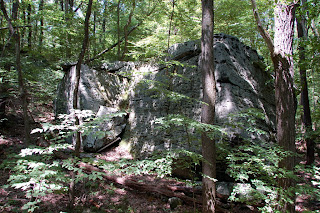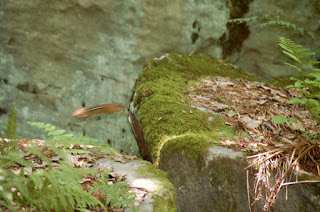On July 2, 1750 Joh Michael Hoffman (widower) was married to Engel Schedlerin in New Hanover township in what is now Montgomery County, Pennsylvania. The marriage was recorded in the records of the Augustus Evangelical Lutheran Church in Trappe, Pennsylvania.
If my theory is correct, Michael and Engel would be my 6th great grandparents. Regardless whether they are or not, one of the places I wanted to visit while in Pennsylvania was the Old Trappe Church. It is reportedly the oldest unchanged Lutheran church still in use in the United States.
According to information posted on the bulletin board outside the church, the congregation was organized about 1730 by John Caspar Stoever, Jr. (who happens to be one of my 5th great grandparents). Worship services were held in a barn loaned by one of the deacons. At that time Stoever was not a regularly ordained pastor but in 1732 he was ordained in the presence of the Trappe congregation. He remained there for a few years before moving on to Lancaster.
Stoever's departure left the spiritual care of the congregation in the hands of a series of self-styled itinerant pastors until late in 1742 with the arrival of Henry Melchior Muhlenberg. In January 1743, members of the congregation began hauling stones to the site and the structure was erected through the spring and summer months. The first service was held in the unfurnished interior on September 12, 1743. The building was completed and dedicated on October 6, 1745. The congregation organized formally, adopting the name "Augustus Lutheran Church." By 1752, the interior of the church building was completed as it appears today.
In 1814, the exterior stone walls were stuccoed and painted to help preserve the building. A woodstove and wooden floor was also added to the interior. In 1860, a severe storm destroyed half of the roof of the Old Church and there was discussion of razing the building but funds were raised to pay for the repairs. In the late 1920s the interior was restored to the colonial appearance with the removal of the stove and the addition of a concrete and flagstone floor. It is now listed as a National Historic site.
In 1852 a new brick church was built a short distance away. The new building is the current church building used by the Augustus Lutheran Church.

The walkway leading to the Old Trappe Church is embedded with plaques from other Lutheran churches around the world. All photographs were taken on October 9, ...

I was fascinated by the shape of the church building.


The raised graves/crypts next to the church building are for members of the Muhlenburg family.

Burials in the cemetery reportedly date from 1729. The oldest legible stone, which I did not find, is dated 1736.

Some of the windows still have the old wavy glass, though I doubt that the panes are from the early 1700s.

Detail of the braces used to keep the shutters open.

I had not pre-arranged for a tour, so was unable to go inside. Shots of the interior were taken by carefully holding the camera up against the window panes. The pulpit on the left side is the only piece of furniture that was not handcrafted by local craftsmen using native woods. It was made of European red walnut and imported at the time the church was dedicated. The top piece over the pulpit is a 'sound board' that amplifies the preachers voice. The offering bags on the far wall were used in the 18th century.

A portion of the concrete and flagstone floor is visible as is the staircase leading to the second floor balcony.



I am always amazed by the craftsmanship and engineering skills of the early builders. Even if this is not The Church of my Hoffman ancestors, it was an incredible feeling to walk around it and to be able to see this magnificent Old Church.




 This old, long photo is of the Transport ship USS Patricia when it was in Boston Harbor, April 28, 1919. This is the ship that my grandpa, John Barnett, came home from WW1 on. There are a few problems, with a few tears in it. But if you look close in the 2nd photo you can see the ancker, in the 3rd photo is the American flag on the front. and if you look close in some others you can see what looks like clothes drying on some of the lines.
This old, long photo is of the Transport ship USS Patricia when it was in Boston Harbor, April 28, 1919. This is the ship that my grandpa, John Barnett, came home from WW1 on. There are a few problems, with a few tears in it. But if you look close in the 2nd photo you can see the ancker, in the 3rd photo is the American flag on the front. and if you look close in some others you can see what looks like clothes drying on some of the lines.


















 Summit shot (photo by Julie Labrecque)
Summit shot (photo by Julie Labrecque)

















